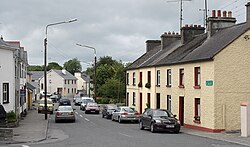Elphin, County Roscommon
| Elphin Gaelic: Ail Finn | |
| County Roscommon | |
|---|---|
 Chapel Street, Elphin | |
| Location | |
| Grid reference: | M868889 |
| Location: | 53°51’0"N, 8°12’-0"W |
| Data | |
| Population: | 950 (2011) |
| Post town: | Elphin |
| Postcode: | F45 |
| Local Government | |
| Council: | Roscommon |
Elphin is a small town in northern County Roscommon. It forms the southern tip of a triangle with Boyle (11 miles) and Carrick-on-Shannon (nine miles) to the north-west and north-east respectively. It is at the junction of the R368 and R369 regional roads. Ireland West Airport Knock is 30 miles west of Elphin - approximately 40 minutes by road.
History
Elphin has historically been an important market town and the diocesan centre for the Diocese of Elphin. St Patrick is believed to have visited Elphin, consecrated its first church and ordained its first bishop, Asicus (subsequently the patron saint of Elphin). Information supporting the visitation of St Patrick is to be found in two important memorials of early Irish hagiography, the Vita Tripartita of St Patrick, and the "Patrician Documents" in the Book of Armagh. On his missionary tour through Connaught in 434 or 435, St Patrick came to the territory of Corcoghlan, present day Elphin. The chief of that territory, a noble Druid named Ono, gave land and afterwards his castle or fort to St Patrick to found a church and monastery. The place, which had hitherto been called Emlagh-Ono (a derivation of its owners name) received the designation of Ail Finn, which means "rock of the clear spring". It derives from a story of St Patrick raising a large stone from a well opened by him in the land of Ono and placed on its margin. A copious stream of crystal water flowed from the well and continues to flow through Elphin to this day. St Patrick built a church called Tempull Phadruig (Patrick's church) and established an Episcopal See in Elphin. St Asicus remained as bishop of Elphin. St Patrick also founded an episcopal monastery or college at Elphin, believed to be one of the first monasteries founded by him. In pre-Reformation times, Elphin was host to a large number of religious orders and was a religious centre of international significance. This is supported by the appearance of Elphin in a number of pan-European maps in the Middle Ages.
After the Reformation Elphin continued as the centre of a bishopric. A new bishop's residence was built in the 1720s to the central block and flanking pavilions plan that is very common in Irish country houses of this period. The main block of the bishop's house was destroyed by fire early in the 20th Century and was subsequently demolished, but the ruins of the pavilions survive together with the curtain walls that linked them to the main house.
The Church of Ireland cathedral was also rebuilt in the eighteenth century. It was a modest building, no bigger than a small parish church, with a tall square clock tower at its west end. An apse was added in the 19th century. The cathedral was used for worship up to 1961. It was badly damaged in a storm on 4 February 1957 and was demolished a few years later,[1] but its partially restored ruins can still be seen.
Associated with the cathedral was Elphin Diocesan School, popularly known as 'The Latin School'. Its most famous students were Oliver Goldsmith and the eye surgeon Sir William Wilde, father of Oscar Wilde. The school was closed in the 1860s when the seat of the bishopric was moved to Kilmore, County Cavan.

According to legend, it was close to Elphin that the mythological figure of Oisin fell from his horse upon his return from Tir na nOg (The Land of Eternal Youth). Within four miles of Elphin is Cruachan (otherwise Rathcroghan), the famous palace of Queen Meave (she of the Táin Bó Cúailnge and a prominent figure in Irish mythology, notably the Ulster Cycle) and the Connaught kings. The well of Ogulla (otherwise the Virgin Monument), scene of the famous conversion and baptism of Aithnea (Eithne) and Fidelm, the daughters of Leoghari, monarch of Ireland in the time of St Patrick, is also situate near Elphin. It is reputed that the gold and riches of Ned Kelly are buried in foothills just outside Elphin.
People
- Percy French, the performer, poet, and water colour artist was born at Cloonyquin, approximately three miles outside of Elphin.
- Arthur Murphy (1727–1805) the lawyer, playwright and biographer of Samuel Johnson, Henry Fielding and David Garrick.
- Murphy's better known contemporary Oliver Goldsmith spent much of his childhood at Ballyoughter, approximately one mile to the south of Elphin and may have been born at his mother's family home, Smith Hill, just outside the village of Elphin.
- Fergus O'Mulconry, one of the authors of the Annals of the Four Masters was born at Cloonahee about two miles from Elphin.
- Elphin is also the birthplace of Roderick Flanagan (1828–1862) the Australian-Irish journalist, historian and anthropologist.
- Luke O'Connor, the first soldier who won the British military award, the Victoria Cross for his actions at the Battle of Alma during the Crimean War was born in Hillstreet, County Roscommon, very near to Elphin.
- Patrick Roddy, recipient of the Victoria Cross
- Jeremiah Fallon (1815-1864), California pioneer, co-founder of Dublin, California, architect of Old St Raymond's Church was born in Elphin.
Windmill

An early 18th-century windmill has been restored in the village.
References
- ↑ "History of St John's". Sligo Cathedral Group. 2011. http://sligocathedral.elphin.anglican.org/?page_id=164. Retrieved 2012-07-20.
Outside links
| ("Wikimedia Commons" has material about Elphin, County Roscommon) |
